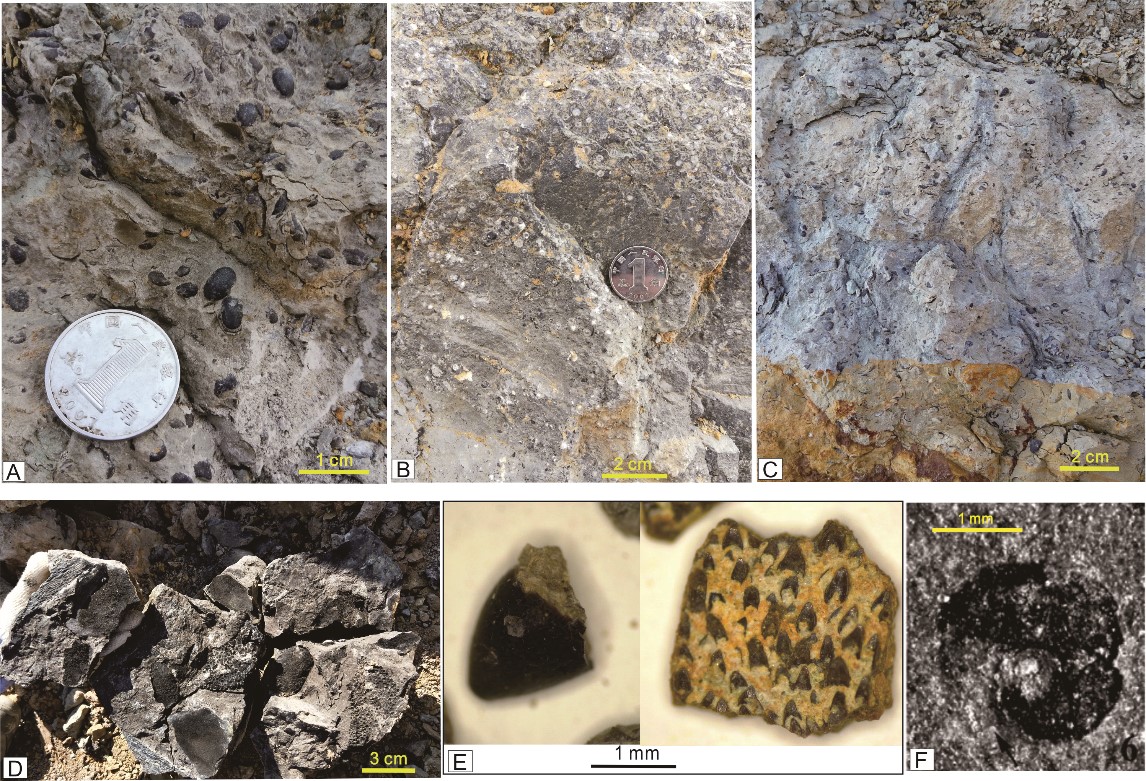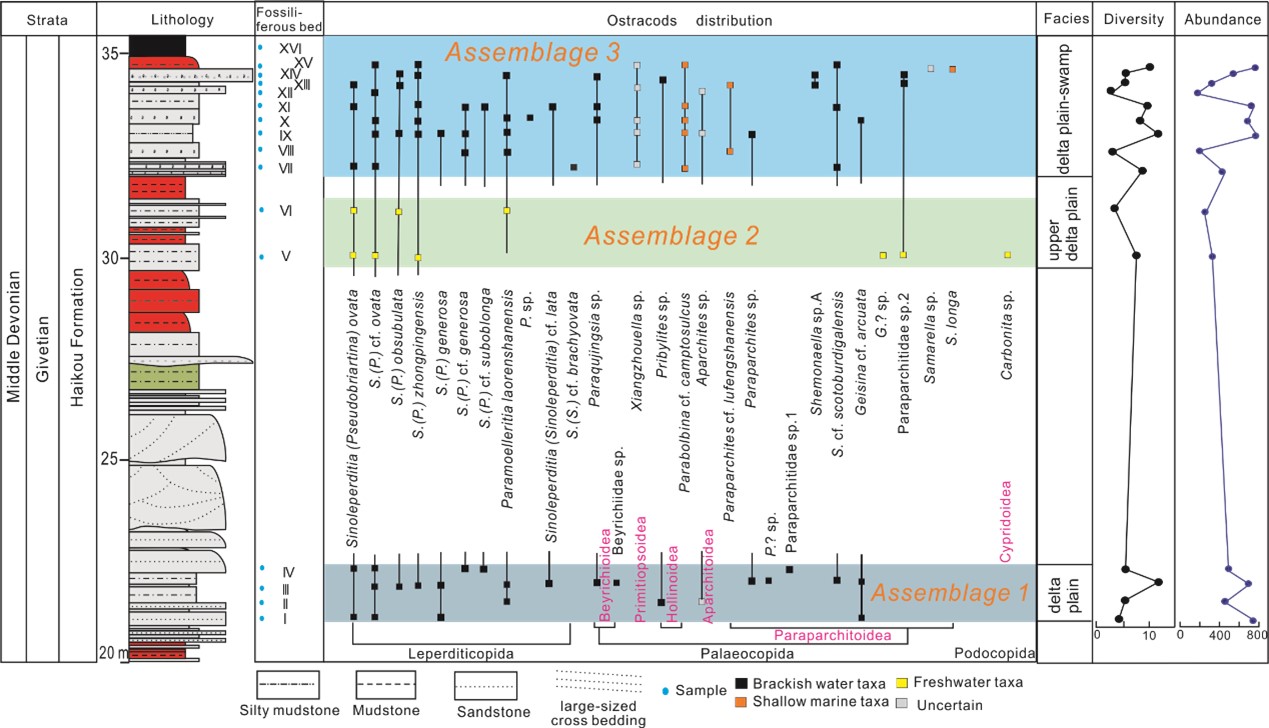Fluvial-delta plain complex links land, fresh water, and marine habitats and acts as a springboard during terrestrialization of both plants and animals. The transitional settingsserved as conduits for active invasion utilized by numerous organisms during the early Paleozoic, notably fishes, tetrapods, gastropods and crustaceans. Its geological records or related paleoecology study, during mid to late Paleozoic, however, are scarce, hindering our understanding of early terrestrial ecosystems.
Recently, a research team led by Associate Professor SONG Junjun, Assistant Professor ZHANG Xiaole, Professor XU Honghe, Associate Professor LI Sha, Professors QIE Wenkun, and WANG Yi from the Nanjing Institute of Geology and Palaeontology, Chinese Academy of Sciences (NIGPAS), conducted a comprehensive multidisciplinary study, incorporating sedimentology, paleontology, and geochemistry on the Middle Devonian Haikou Formation in Wuding, Yunnan.
This research reconstructed the paleoecology and paleoenvironment of the Middle Devonian continental-transitional facies, explored new models of organism-environment co-evolution during this period, and provided new evidence for the early process of organisms colonizing land. The research was recently published in the Earth-Science Reviews.
The Devonian strata in the Wuding area of Yunnan are well-developed, with the late Middle Devonian Haikou Formation featuring diverse sedimentary structures and abundant fossil organisms, laying a solid foundation for comprehensive multidisciplinary research. Through extensive fieldwork and laboratory studies, the research team identified a fluvial-delta plain complex system in the Haikou Formation using sedimentological, geochemical, and paleoecological evidence. The lower part of the Haikou Formation deposited in a meandering fluvial environment. While the middle-upper part of the Haikou Formation is interpreted as a brackish-fresh water setting (i.e., delta plain-swamp) based on facies analysis, stable isotope composition (δ18O, δ13C) of biogenic (ostracods) and authigenic carbonates, as well as paleosalinity proxies (Sr/Ba).
A synthetic biota with a variety of fossil organisms, including ostracods (29 species belonging to 7 superfamilies), charophytes (1 species), chondrichthyans and antiarch fishes (at least 2 taxa), gastropods (1 taxa), bivalves, and spores (20 species belonging to 19 genera) have been recognized and identified in thedelta plain-swamp facies. Ostracods are categorized into three distinct assemblages.Assemblages 1 (Leperditicope-Palaeocope assemblage) and Assemblages 3 (Paraparchitoidean assemblage) displaying high diversity and abundance, and characterize a brackish lower delta plain and a delta plain-swamp environment, respectively. Whilst the Assemblage 2 (Leperditioidean assemblage) has relatively low diversity and inhabited in fresh water, probably an upper delta plain setting. These abundant ostracod fossils provide important evidence for exploring the origin and evolution of continental ostracods. Previously, the academic community generally believed that the earliest freshwater ostracods appeared in the early Mississippian of the Carboniferous (ca. 350 Ma). However, this study discovered a species of Carbonita sp. (Cypridoidea), a freshwater ostracod superfamily never reported before the Carboniferous. This indicates that the origin of modern freshwater ostracods may date back to no later than the Middle Devonian, approximately 30 million years earlier than previously recognized. Additionally, by systematically reviewing pre-Carboniferous non-marine ostracod records and integrating their own research data, the researchers suggest that Leperdiditioideans are pioneers colonized fluvial-delta plain setting and might be the earliest fresh water ostracods.
The biota, especially those of the ostracods and charophytes, comprise a complex ecosystem spanning the marginal marine to terrestrial settings allowing a well-structured reconstruction of the eco-pyramid of brackish-fresh water ecosystem during the Middle Devonian. It is including producers (charophytes, green algae, vascular plants, etc.), primary consumers (ostracods, gastropods, bivalves, etc.), and secondary consumers (fish). This reflects a complex and stable ecosystem transitioning from the ocean to land during the Paleozoic. Abundant rhizomes of vascular land plants, as well as vertically arranged traces fossils (i.e., Scoyenia beerboweri) are observed from the flood plain facies, representing development of belowground soil ecosystem.
This research represents the first systematic reconstruction of the paleoenvironment and paleoecology of the Middle Devonian fluvial-delta plain system, providing critical evidence for understanding the organism-environment co-evolution in Devonian non-marine ecosystems. The unique animal and plant biota in the Haikou Formation of the Wuding area represents a new brackish-freshwater ecosystem in the eastern Tethys during the Middle Devonian, offering an important research carrier for further studies on the early land colonization process and paleoenvironmental changes.
This study was supported by the National Key Research and Development Program of China, the Youth Innovation Promotion Association of the Chinese Academy of Sciences, and the National Natural Science Foundation of China.
Reference:Song, J.J., Zhang, X.L., Li, S., Qie, W.K., Wang, Y., & Xu, H.H. (2025). A Middle Devonian fluvial-delta plain complex from eastern Yunnan, South China: Insights into co-evolution between environments and organisms in an early non-marine system. Earth-Science Reviews, 105223. https://doi.org/10.1016/j.earscirev.2025.105223.

Outcrop of the study section- Wuding section, eastern Yunnan,South China.

Fossils from the Middle Devonian Haikou Formation in the Wuding section eastern Yunnan, South China.

Ostracods distribution of the Middle Devonian Haikou Formation in the Wuding section, eastern Yunnan, South China

Summary depositional model and paleoecology for the Middle Devonian Haikou Formation in the Wuding section, eastern Yunnan, South China.
Download:
